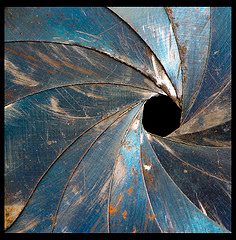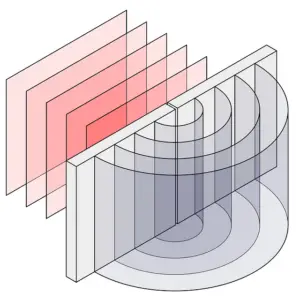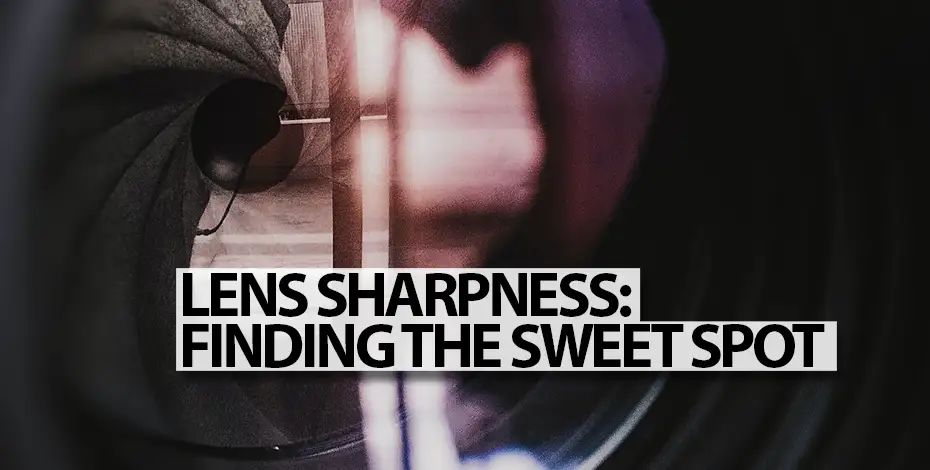Increasing Depth Of Field (DOF) beyond a certain point can actually make your photographs slightly blurry. Isn’t that strange? This is because of diffraction. If you want to get as much of a scene in sharp focus, you often must use a small aperture to get more depth of field. Unfortunately physics interferes and makes your photos softer after a certain aperture setting. We’ll look into this phenomenon, called “diffraction” in this article, and learn how to reduce the effects of diffraction to get sharp photos.
Lens Sharpness And Extreme Aperture Settings
If you want the sharpest pictures that your lens can give you, remember not to use its largest and smallest apertures. Most lenses are optimized to be used in the f/5.6 – f/11 aperture range and give their best performance when stopped down a couple of f-stops from the widest aperture or opened up from the smallest aperture.
At their widest apertures, lenses are limited by the quality of the lens itself – by various types of aberrations. On the other hand, at their smallest apertures lenses affected by a phenomenon called “diffraction” which causes light rays to bend and create softer images.
This means that most lenses are not working to their best capabilities at their extreme aperture settings, both largest, and smallest apertures.
What is The Aperture?

The Aperture of a lens is the variable opening in a lens which controls how much light is allowed to enter through the lens, and into the camera’s body to fall on the focal plane. The aperture consists of multiple movable leaves that change position to allow more or less light through.
The opening size is measured as an f-stop.
A larger aperture opening is denoted by a smaller f-stop number like f/2.8 or f/3.5, whereas a smaller aperture opening is denoted by a larger f-stop number like f/22 or f/32. Smaller apertures give the image more depth of field (more depth in the image is in focus) and larger apertures give it a shallower depth of field.
Depth of Field is the area in front of the lens that is in acceptable focus. It varies based on aperture size and focal length of the lens.
What is Diffraction?
Diffraction refers to the bending and spreading of light when they pass through a gap, or around an object that is of a similar size to the wavelength of the light itself.
In short diffraction is a phenomenon where light waves bend as they pass through an opening, or around the edge of an object.

Diffraction in Photography
Diffraction is a critical factor that affects image sharpness in photography. When light passes through the aperture of a camera lens, it diffracts or bends around the edges of the aperture blades. This bending causes the light waves to spread out and interfere with each other, creating a diffraction pattern.
The degree of diffraction is inversely related to the size of the aperture. When the aperture is wide open (low f-number like f/2.8), the amount of diffraction is minimal because the light has a large opening to pass through. As a result, images taken with a wide-open aperture can be very sharp even if they have shallow depth of field.
However, as the aperture becomes smaller (high f-number like f/22), the opening that the light passes through narrows. This smaller opening causes the light to diffract more, which can lead to a loss of sharpness in the image. This is because the spreading out of light waves causes them to interfere with each other, blurring the fine details in the image.
When you use a small aperture with f-stop numbers like f/22 or f/32, the opening through which light passes is so small that it tends to bend just a little. Unfortunately, since the entire image is passing through this small opening, the entire field of view loses some of its sharpness. This results in a loss of overall sharpness across the image even though there is more depth of field (DOF).
Balancing Depth of Field and Diffraction of Light
Every lens has a “sweet spot” for sharpness, and this isn’t usually documented. You’ll understand which apertures work best as you use the lens and see the results.
Finding the sweet spot for lens sharpness is a balancing act between minimizing lens aberrations (which are more prominent at larger apertures) and minimizing diffraction (which is more prominent at smaller apertures).
However, in principle, stopping down from the widest aperture, or opening up from the smallest apertures by one or two stops will place you in your lens’ sweet spot for maximum sharpness.
Finding The “Sweet Spot” in Your Lens
The sweet spot of a lens is typically a mid-range aperture where the effects of lens aberrations and diffraction are both minimized. This is often around two to three stops down from the lens’s maximum aperture. So, for a lens with a maximum aperture of f/2.8, the sweet spot might be around f/5.6 or f/8.
However, the exact sweet spot can vary from lens to lens. It’s also important to note that the sweet spot only refers to the sharpness of the lens. Depending on the photographic situation, other factors such as depth of field needed, or the amount of light available, it might be preferable to use an aperture setting outside of this sweet spot.
The best way to find the sweet spot of your specific lens is through experimentation: take the same photo at different aperture settings and compare the results for sharpness.
Exceptional Lenses For Large Apertures
Large apertures are great for low-light scenes, but unless you have an exceptional lens, it’s likely that you will get a soft image at your lens’s largest aperture. It’s quite difficult to design and build lenses that are razor-sharp at their widest aperture, and also without chromatic aberration.
There are always exceptions to every rule, and some lenses made by Carl-Zeiss and Leica deliver exceptional sharpness even at extremely wide apertures like f/1.2 (or f/0.95 as the case may be). However, even these amazing lenses are susceptible to the effects of diffraction.
They may be marvels of science, but they can’t escape the reality of physics. And diffraction is very real.
Wrapping Up; About Diffraction
In conclusion, achieving optimal sharpness in photography is a balancing act. While large apertures can lead to lens aberrations and small apertures can cause diffraction, each lens has a ‘sweet spot’ that offers the best sharpness. This is typically found at mid-range aperture settings, often two to three stops down from the lens’s maximum aperture. However, the exact ‘sweet spot’ can vary from lens to lens and depends on other factors such as the depth of field needed, the amount of light available and even shutter speed. Therefore, it’s crucial for photographers to experiment with different aperture settings to find the best balance for their specific lens and situation.
Try experimenting with your lens, and see what happens to the sharpness of your image when photographing fully stopped down on your lens. Next, try different settings in the same controlled environment to push your lens to its limits and figure out at which aperture settings you’re the happiest with the results.
Let us know the results of your experiment, and which aperture(s) you’ve chosen as your lens’s sweet spot.
Read more “Tiny Tips” from Beyond Photo Tips
Help Us To Continue Creating
Get our email newsletter to stay up-to-date with our latest posts. It’s easy to read and is mailed once in 2 weeks.
The easiest way to support Beyond Photo Tips is by using our affiliate links when you buy anything at all. It will never cost you anything extra, and we get a small commission from it, which helps us a LOT! We share our recommended equipment list here.
Some of the links to products on this website are affiliate links, and we only ever link out to gear that we recommend.
You could also show your appreciation by buying us a coffee. Finally, we appreciate you being a part of the community, so do say hi!







Great tip. This is something I’ve been aware of for a long time, but many are unaware of this. Nice concise post on the topic.
Thanks Jim,
There are a lot of people getting into photography these days… many without a photographic background. These are the ones that will find tips like this useful.
Um Hmm, so true! I just got a 50mm f1.8 and I am struggling to nail the focus. I’ll take these tips and keep trying.
Tamika: Thanks for commenting.
I do understand how frustrating it can be to have to work with a large aperture… it can also be a joy!
In the tip, I was talking about producing lenses that take sharp pictures at f/1.8. However, f/1.8 is a really wide aperture, and at times, the depth of field is negligible, so try stopping down if you want more of the picture in sharp focus.